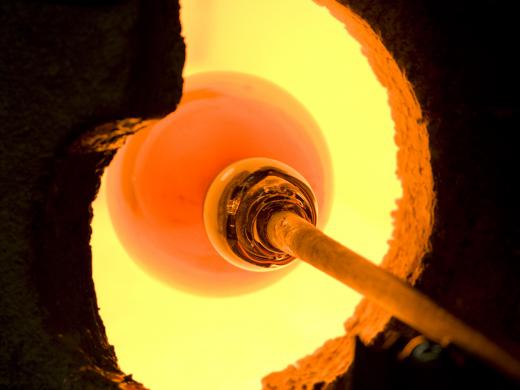A number of glass production techniques are in use around the world. Float glass and glassblowing are two of the most common and important methods. The best production method depends on how the glass will be used, as different techniques may bring out different traits in the finished product. It is also important to select appropriate raw materials. For things like scientific glass and cooking containers, the glass needs to be durable, resistant to high temperatures, and very strong.
In float glass production, manufacturers pour liquid glass across a hot bath of molten tin. The two components do not mix, and the glass forms a thin layer on the top. The resulting sheet glass can move slowly through the facility to cool down until it is ready to cut. Manufacturers that use this production method have extremely large facilities to accommodate all the different stages of production.

Historic sheet glass production methods were less reliable and tended to create wavy patterns in the glass. The distinctive appearance of older glass panes is often attributed to the aging of the glass over time. This is not actually the case; the glass had the same ripples and slumped appearance when it was new.
Glassblowing involves the inflation of glass to hollow it out and create a vessel. It is possible to create a free-form object or to blow into a mold. Historically, glass was produced by rolling clay molds in molten glass, waiting for it to cool, and then breaking up the mold to remove it and leave the finished glass vessel behind. When this technique was replaced by glassblowing, it was a significant development in the history of glass production.

Glass can also be rolled in a production method where partially melted glass is squeezed between giant rollers to create a flat sheet. For tiles, glass production techniques can include firing glass paste in molds until it fuses, and the creation of slumped glass using textured molds to emboss and shape the glass during firing. Glass tile producers may also use scraps of glass fired in a mold to create a patterned and solid piece of glass.
Art conservators must be familiar with glass production techniques if they work with glass objects. It can be important for understanding how a piece was made. If it has a problem, such as instability due to impurities, knowledge of the production techniques can help the conservator fix the glass appropriately. While glass is normally extremely strong and stable, some antique pieces are fragile and require special care.
Ever since she began contributing to the site several years ago, Mary has embraced the exciting challenge of being a About Mechanics researcher and writer. Mary has a liberal arts degree from Goddard College and spends her free time reading, cooking, and exploring the great outdoors.

